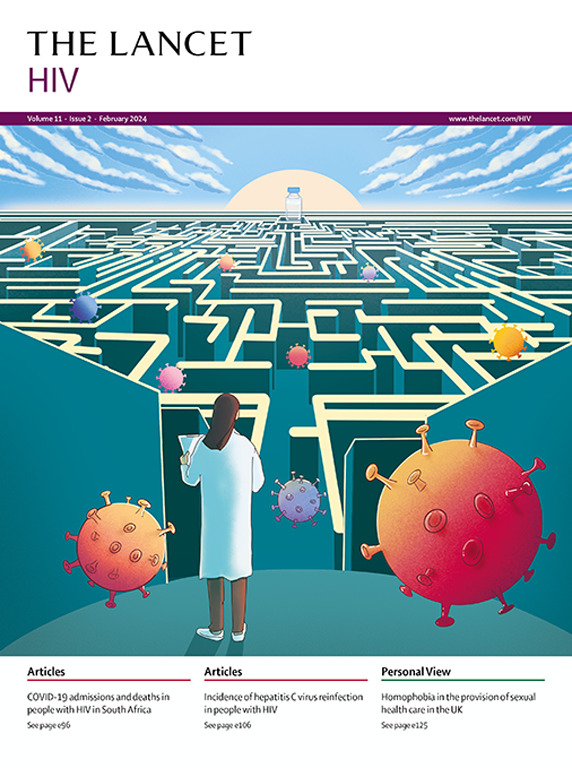早期ART治疗后子宫内HIV-1患儿无ART缓解(IMPAACT P1115):一项多中心、开放标签、1/2期概念验证研究
IF 13
1区 医学
Q1 IMMUNOLOGY
引用次数: 0
摘要
我们假设出生后不久开始抗逆转录病毒治疗(ART)可以限制HIV-1储存库并促进无ART缓解。本研究旨在通过实施分析性治疗中断(ATI)来评估新生儿早期接受抗逆转录病毒治疗的宫内HIV-1感染儿童的缓解情况。simpaact P1115是一项正在进行的、开放标签的、概念验证的研究,在非洲、亚洲和美洲的11个国家的30个研究地点进行。子宫内HIV-1感染高危新生儿(≥34周孕龄)入选。未经治疗的HIV-1母亲(队列1)或可能接受过抗逆转录病毒治疗的母亲(队列2)所生的新生儿在出生后48小时内开始以奈韦拉平为基础的三种药物口服抗逆转录病毒治疗(每剂量6mg/kg,每天口服两次)(队列1),以奈韦拉平为基础的三种药物预防(每剂量≥8mg /kg,每天口服一次),或在HIV-1诊断后10天内以奈韦拉平为基础的抗逆转录病毒治疗(队列2)。当确认子宫内HIV-1的患者年龄合适时,加入利托那韦75 mg/m2和洛匹那韦300 mg/m2的复方,每日2次,口服。在连续两次血浆病毒载量低于测定限后12周停用奈韦拉平。自第48周以来,至少2岁的儿童仍未检测到HIV-1 RNA,并且HIV-1抗体检测为阴性,HIV-1 DNA未检测到,CD4计数和百分比正常,符合ATI资格。主要结局是无ART缓解,定义为停止ART治疗48周或更长时间血浆中没有HIV-1 RNA。计算双侧精确95% CI来估计缓解的概率。该研究已在ClinicalTrials.gov注册(NCT02140255)。在2015年1月23日至2017年12月14日期间登记的54名子宫内HIV-1儿童中,6名(11%)儿童(4名女孩,2名男孩;队列11名,队列2 5名)符合标准并在中位年龄为5.5岁时接受了ATI治疗。2例患儿在3·4周和9·4周出现早期反弹。4例达到无art缓解(67%;确切95% CI 22-96),其中1例在73.3周时出现晚期病毒反弹。所有三名病毒反弹的儿童都成功地将HIV-1 RNA重新抑制到低于ART检测极限的水平。两名参与者在反弹期间出现轻微的急性逆转录病毒综合征症状,并在恢复抗逆转录病毒治疗后消退。这项研究表明,在子宫内感染HIV-1的儿童中,早期抗逆转录病毒治疗可以实现48周或更长时间的无ART缓解,但在ATI期间需要密切监测病毒反弹和急性逆转录病毒综合征。在资源有限的国家观察到的这些发现表明,在出生时进行检测和早期开始抗逆转录病毒治疗是可行的,显示出限制HIV-1病毒库以实现无抗逆转录病毒治疗缓解的潜力,并为未来的缓解策略提供信息。资助:美国国家过敏和传染病研究所,尤尼斯·肯尼迪·施莱弗国家儿童健康和人类发展研究所,以及美国国家心理健康研究所。本文章由计算机程序翻译,如有差异,请以英文原文为准。
ART-free HIV-1 remission in children with in-utero HIV-1 after very early ART (IMPAACT P1115): a multicentre, open-label, phase 1/2 proof-of-concept study.
BACKGROUND
We hypothesised that initiating antiretroviral therapy (ART) soon after birth could limit HIV-1 reservoirs and promote ART-free remission. This study aims to assess remission in children with in-utero HIV-1 infection who received very early ART as neonates by performing analytical treatment interruption (ATI).
METHODS
IMPAACT P1115 is an ongoing, open-label, proof-of-concept study at 30 research sites in 11 countries across Africa, Asia, and the Americas. Neonates (≥34 weeks gestational age) at high risk for in-utero HIV-1 were eligible. Neonates born to mothers with untreated HIV-1 (cohort 1) or mothers who might have been on ART (cohort 2) initiated three-drug oral nevirapine-based ART (6mg/kg per dose orally twice a day) within 48 h of birth (cohort 1), three-drug nevirapine-based prophylaxis (≥8 mg/kg per dose orally once a day), or nevirapine-based ART after HIV-1 diagnosis by age 10 days (cohort 2). Coformulated ritonavir 75 mg/m2 and lopinavir 300 mg/m2 orally twice a day was added when age appropriate for those with confirmed in-utero HIV-1. Nevirapine was discontinued 12 weeks after two consecutive plasma viral loads were below the assay limit. Children at least 2 years of age maintaining undetectable HIV-1 RNA since week 48 and who tested HIV-1 antibody negative, HIV-1 DNA not detected, and normal CD4 count and percentage qualified for ATI. The primary outcome was ART-free remission, defined as no HIV-1 RNA in plasma for 48 weeks or more off ART. A two-sided exact 95% CI was calculated to estimate the probability of remission. This study is registered with ClinicalTrials.gov (NCT02140255).
FINDINGS
Among 54 children with in-utero HIV-1 enrolled between Jan 23, 2015, and Dec 14, 2017, six (11%) children (four girls, two boys; one in cohort 1, five in cohort 2) met criteria and underwent ATI at a median age of 5·5 years. Two children had early rebound at 3·4 weeks and 9·4 weeks. Four reached ART-free remission (67%; exact 95% CI 22-96), one of whom had late viral rebound at 79·3 weeks. All three children with viral rebound successfully resuppressed HIV-1 RNA below the assay limit on ART. Mild symptoms of acute retroviral syndrome occurred in two participants during rebound and resolved with ART resumption.
INTERPRETATION
This study shows that ART-free remission for 48 weeks or longer is achievable with very early ART in children with in-utero HIV-1, but close monitoring for viral rebound and acute retroviral syndrome during ATI is needed. These findings, observed in resource-constrained countries, exhibit the feasibility of testing at birth and initiating very early ART, show the potential to limit HIV-1 reservoirs for ART-free remission, and inform future remission strategies.
FUNDING
The US National Institute of Allergy and Infectious Diseases, the Eunice Kennedy Shriver National Institute of Child Health and Human Development, and the US National Institute of Mental Health.
求助全文
通过发布文献求助,成功后即可免费获取论文全文。
去求助
来源期刊

Lancet Hiv
IMMUNOLOGYINFECTIOUS DISEASES&-INFECTIOUS DISEASES
CiteScore
19.90
自引率
4.30%
发文量
368
期刊介绍:
The Lancet HIV is an internationally trusted source of clinical, public health, and global health knowledge with an Impact Factor of 16.1. It is dedicated to publishing original research, evidence-based reviews, and insightful features that advocate for change in or illuminates HIV clinical practice. The journal aims to provide a holistic view of the pandemic, covering clinical, epidemiological, and operational disciplines. It publishes content on innovative treatments and the biological research behind them, novel methods of service delivery, and new approaches to confronting HIV/AIDS worldwide. The Lancet HIV publishes various types of content including articles, reviews, comments, correspondences, and viewpoints. It also publishes series that aim to shape and drive positive change in clinical practice and health policy in areas of need in HIV. The journal is indexed by several abstracting and indexing services, including Crossref, Embase, Essential Science Indicators, MEDLINE, PubMed, SCIE and Scopus.
 求助内容:
求助内容: 应助结果提醒方式:
应助结果提醒方式:


